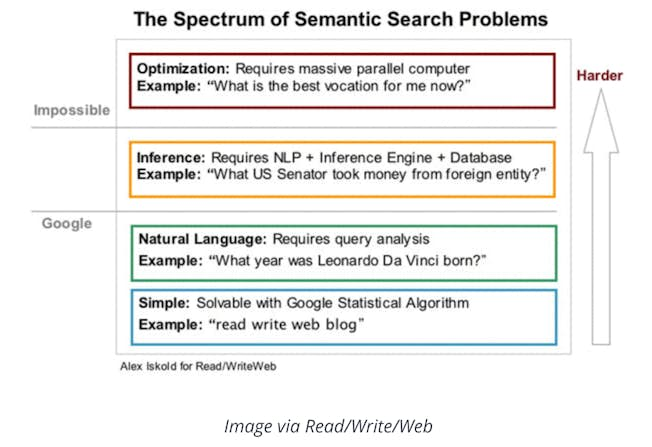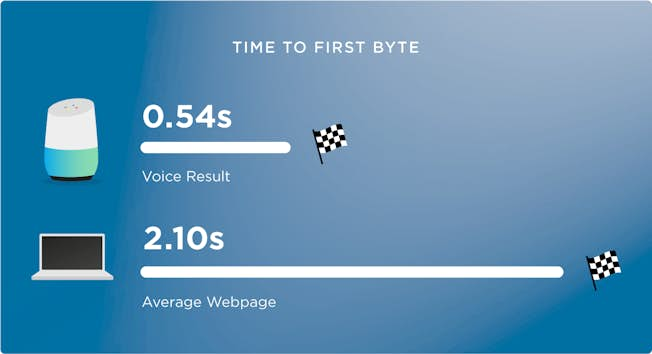Dec 28, 2022
Prepare for the Future of Voice Search
There are plenty of impressive statistics regarding digital assistants and voice search. To cite just a few:
- Over 25% of the global online population use the voice search on mobile devices (Source: Microsoft)
- One third of U.S consumers own a smart speaker - Statista
- The use of digital voice assistants will triple to 8 billion by 2023 driven by smart home devices - Juniper Research
- The transaction value of purchases made through voice assistants on smart home devices globally is predicted by Statista to reach $164 billion in 2025
Clearly, this is a growing industry and there’s huge scope for customer engagement and advertising opportunities.
Devices such as Google Home, Homey and the Amazon Echo range are increasingly prominent in living rooms, kitchens and bedrooms in Western countries. Furthermore, anthropomorphic assistants such as Siri, Alexa and Google Assistant are embedded in a wide range of smartphones, cars, and even vacuum cleaners.

It is a trend that sits at the intersection of increased mobile use, sophisticated machine learning algorithms, and the symbiotic relationship between people and technology. As such, its continued rise seems inexorable.
But what does this really mean for brands? Does voice search require a separate strategy? And if so, what does it entail?
This article will examine what we know about voice search and give you some tips that will help integrate voice into your marketing strategy.
Voice Search: A Natural Extension of Semantic Search
The evolution of communication begins with speech and moves on to written language. However, search engines have experienced this in reverse.
The signals that we innately pick up on, such as intonation or memories of past interactions, are difficult to incorporate into a search engine.
When I ask a friend, “What would be the best smartphone for me to buy?”, they can tailor the recommendation based on my preferences.
Scaling that level of insight requires significant natural language processing power, along with the information retrieval technology to sift through billions of results and locate the right one. Smartphones provide more contextual information than desktop computers, but a search engine still needs a reliable way to process and utilize so much data.
The image below highlights the levels of difficulty for a search engine and the technology required in each case:

This matters when we consider voice search strategy. People adapt their behaviors based on the possibilities at their disposal. As marketers, understanding those behaviors is essential if we want to cut through the noise and connect.
Brands create the content that leads a consumer from question to answer. A search engine is the interlocutor that makes the connection.
Google’s Hummingbird algorithm ushered in the age of semantic search, making use of the Google Knowledge Graph to understand the relationship between entities and deliver something approaching conversational search.
Ask Google “Who is the king of Spain?”, and it will respond “King Felipe VI”. Next, ask “Who is his wife?”, and it will respond “Letizia of Spain”.
Google infers that ‘his’ refers to King Felipe. This is a subtle but significant shift that affects how we should create and promote content through search. We can now have conversations through search engine optimization (SEO), rather than one-off exchanges.
Semantic search is changing how people find information and it is heightening their expectations. As the search engine’s capabilities change, so should ours as marketers.
In essence, this development is a natural and vital component of voice search’s rise. Google reports that people are increasingly searching for queries using words such as ‘me’, ‘my’ and ‘I’.
As an indicator of the modern consumer’s requirements from online content, this is very telling. People would only ask these questions if they expect the answer to be personalized and unique to them. These searches are typically carried out by voice, rather than text.
Once more, this points to the difference between voice search and traditional search. Consumers are treating digital assistants as exactly that, a personal helper to get things done quicker and easier than before. We expect the assistant to ‘know’ us.
Another question that is often raised is just how genuine the commercial opportunity is for voice search.
A 2017 study from iProspect revealed that while people predominantly use voice search to get information, such as weather forecasts, or enable actions like turning on lights and playing music, they are also using them to find stores, research and purchase.
Moreover, the distinction between voice search on mobile and with a smart home device is rather marked. This is perhaps to be expected, given that we carry mobile devices with us and they have screens, whereas home devices tend not to, but it does bring important implications for brands. Mobile phone screens provide a canvas on which to display choice and information, while a home device must deliver one, authoritative answer.
And the ecommerce sector is taking note as Walmart acquired conversational AI-startup Botmock, and partnered with Google to allow customers add items to their virtual shopping cart through Google Assistant. Target and Carrefour also struck such deals with Google, and Ocado has partnered with Amazon to create a similar experience through Alexa.
From this, we can start to understand the drivers – both technological and human – that have seen voice search grow so rapidly.
Voice Search Best Practices
Technical SEO
- Focus on speed and mobile-friendliness. A study of 10,000 voice search results by Backlinko shows that the time to first byte for a voice search result is significantly shorter than for the average webpage. With Google’s “speed update” rolling out for all users now, this should be the first port of call for any mobile or voice search strategy.

- Use structured data on all landing pages. One sizeable challenge for digital assistants is that they must comb through trillions of pages to identify the elements that will answer a user’s query. Structured data, taken from the Schema.org standard, helps a search engine to navigate code and understand its contents.
- Experiment with new data formats. Google supports the Speakable structured data element which is useful when asking for specific topics and news related to a particular brand or event. In Google’s words:
“In order to fulfil news queries with results people can count on, we collaborated on a new schema.org structured data specification called Speakable, for eligible publishers to mark up sections of a news article that are most relevant to be read aloud by the Google Assistant.”
The application of this format is limited for now, but it’s not difficult to imagine a future where digital assistants read content directly from all landing pages. Early movers will seize the advantage in this field
Content Marketing
When it comes to voice search, the area it can have a huge impact is in content marketing. It can help you to:
- Create conversational content - Voice search lends itself naturally to dialogue, which should be factored into content strategy. Identify common questions or pain points in your industry and, quite simply, answer them better than anyone else does.
- Write for intent states, not keywords - Voice search queries tend to be much more varied than their typed counterparts. As such, trying to target individual queries within content is a challenging and unnecessary approach. Search engines want to satisfy user intent. Aim to understand and respond to these states, helping people to achieve their task quickly and effectively. This will be more profitable than creating landing pages to target individual queries.
- Develop a consistent brand voice - The future of voice search will involve brands speaking to their audience. This could be in the form of audio clips embedded in content or the search engine reading out text from the page. Either way, brands should be thinking of how they want their company to sound, rather than just look.
Furthermore, Google offers the following areas for assessment when it comes to this kind of voice search:
- Information satisfaction: The content of the answer should meet the information needs of the user.
- Length: When a displayed answer is too long, users can quickly scan it visually and locate the relevant information. For voice answers, that is not possible. It is much more important to ensure that we provide a helpful amount of information, hopefully not too much or too little.
- Formulation: It is much easier to understand a badly formulated written answer than an ungrammatical spoken answer, so more care has to be placed in ensuring grammatical correctness.
- Elocution: Spoken answers must have proper pronunciation and prosody. Improvements in text-to-speech generation, such as WaveNet and Tacotron 2, are quickly reducing the gap with human performance.
Local SEO
- Ensure that names, addresses and phone numbers are accurate across all locations. The partnership between Amazon and Yext points to one very clear voice search opportunity for brands, but it is dependent on brands supplying accurate and consistent location information.
- Consider using a specialist platform to manage local listings and analyze your local search performance. There is a growing range of SEO ranking tools and mobile SEO tools that can help with these tasks.
- Make it easy for consumers to act on their intentions. This means adding in clear calls to action and directions to further information. Attention spans are at a premium for voice search, so make the most of what little time you do get.
SEO Strategy
- Think beyond the website. Chatbots, apps and social media are all used to surface information for voice search queries. Therefore, you should optimize your presence across all of these in a consistent brand voice.
- Use voice queries to plan future products and services. Within an app, it is possible to track and store all voice queries. This can be an invaluable resource when it comes to planning new services, as any unanswered queries will provide ideas with proven demand.
- One real challenge with voice search is that it is not yet possible to segment queries within Search Query Reports or Search Console to see which were typed versus spoken. That will certainly come, but for now marketers should aim to extract maximum value from the limited data at our disposal.
Integrate voice into your digital marketing strategy
Understand the fundamentals of digital marketing from social media marketing to analytics, website optimization and PPC so you can plan for voice search in your campaigns. DMI’s Professional Diploma in Search Marketing in partnership with expert Neil Patel will provide you with industry insights, up-to-date knowledge and in-demand skills to boost your knowledge and career.
Related
Upgrade to Power Membership to continue
your access to thousands of articles, toolkits, podcasts, lessons and much much more.
Become a Power Member- Login
- View Courses
- - - -
- Courses
- Resources
- - - -
- My Account
- Change Password
- Logout





